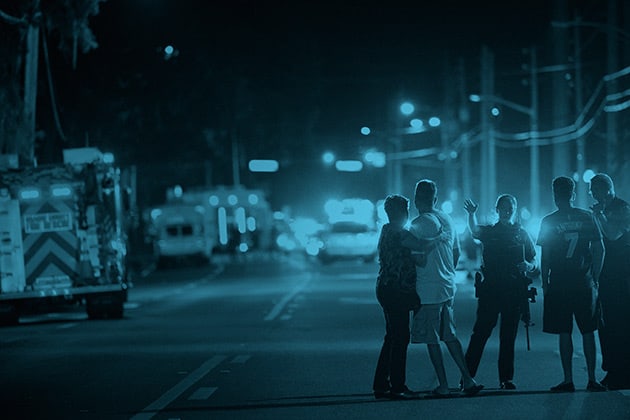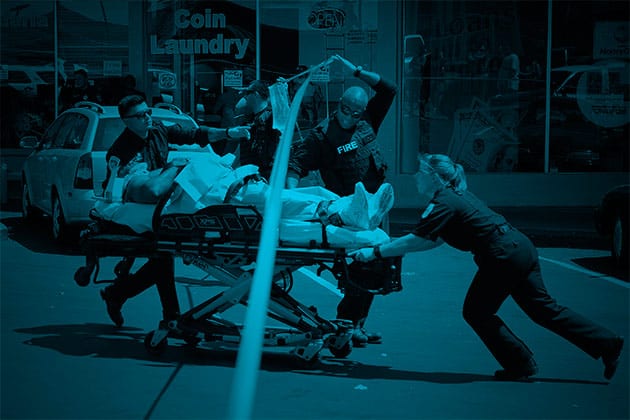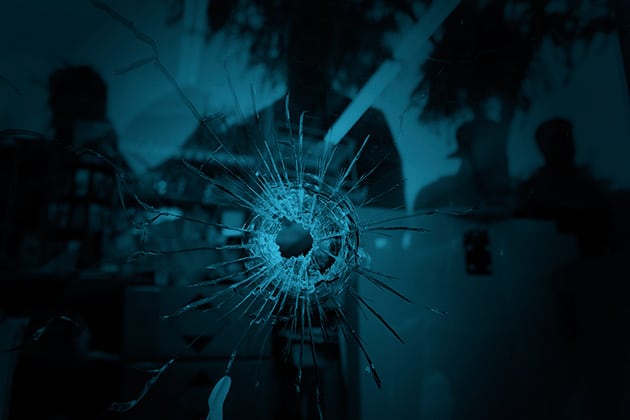Published On June 13, 2017
IN THE DAYS AFTER the World Trade Center attack in 2001, confusion reigned on the ground. New York City’s agencies scrambled to coordinate a response to an attack the city could not possibly have prepared for. “We’re used to the civilian world: We go in and everyone knows what to do,” says Glenn Asaeda, chief medical director at the New York City Fire Department. “Law enforcement secures the area, the fire department puts out fires, emergency medical services (EMS) comes in and treats the patients.” But here, agencies were unclear about their responsibilities; emergency departments scrambled to find the equipment needed to handle a flood of trauma patients; and a state of shock gripped not only the responders, but the whole city, as everyone waited to see what would happen next.
In the confusion of that day, Boston hospitals were told to prepare to receive two trains full of critically injured patients. The casualties never arrived—but if they had, the city’s plans for responding to a disaster could have caused problems, says Alasdair Conn, emeritus chief of emergency medicine at Massachusetts General Hospital. “We would have run out of ventilators, for one thing,” says Conn, who spent much of that day calling colleagues around the city to ask for the equipment.
After 9/11, plans for handling the next terror attack became a top priority for all hospitals. As part of its effort, MGH brought in Israeli consultants who had extensive experience with urban terrorism. “They shared their experience of handling the response to these attacks in a data-driven way,” says Paul Biddinger, director of the MGH Center for Disaster Medicine. For example, did the hospital know how long it would take—exactly—for an injured person at, say, Boston Common to get to their doors? MGH staged a full-scale trial of its pre-9/11 disaster plan and discovered, according to Biddinger, that many assumptions built into it were simply wrong.
In addition to internal communication and coordination shortfalls, their plan misjudged how patients would get to the hospital, how they would be distributed among different institutions, and who would decide what to do with them when they arrived. The MGH plan also assumed the hospital might have about 20 minutes after a bombing to get ready to receive patients. The Israeli specialists said that they might only have four.
MGH and other Boston hospitals updated their plans and continued to test them in the years that followed. When their day of reckoning came in 2013, with the bombing at the Boston Marathon finish line, that network of emergency responders was able to save the life of every patient who made it to a hospital.
But many of the country’s hospitals are not nearly as well prepared. In 2014, in its most recent assessment, the American College of Emergency Physicians gave the United States a grade of C– in disaster preparedness, and many states got even lower marks. “Our biggest challenge is the unevenness,” says Biddinger. “We have pockets of excellence but also many places that are not ready.”
Whereas major terrorism attacks may be infrequent, a steady creep of smaller casualty events are showing up at emergency-room doors across the country. Gun violence against multiple victims, in particular, is on the rise. In 2014, there were 274 incidents in the United States in which four or more people were shot or killed; in 2015 there were 334; and in 2016, 384. Such attacks can happen anywhere. “If you’re in a community that has a movie theater, like Aurora, Colorado, or you have an elementary school, like Sandy Hook, or a university, like Virginia Tech, or a sporting event, like the Boston Marathon—you’re at risk,” says Conn.
One way to lift up smaller communities may be to include them in a national response network, says Ronald Stewart, chair of the department of surgery at the University of Texas Health Science Center at San Antonio and head of the committee on trauma for the American College of Surgeons. He believes the nation needs a plan for communication and cooperation among all emergency medical personnel and nurses, emergency room physicians, trauma surgeons and trauma centers.
A coordinated, nationwide trauma response would connect hospital, city and county systems. Moreover, Stewart says, there should be multiple, redundant layers of communication—so that if the Internet or landlines are knocked out, everyone knows to turn to plan B. Government emergency operations centers also need to be looped in. “A network of regional trauma systems interlinked across the United States is the most powerful protection we have to offer,” he says.

SETTING UP COORDINATED NETWORKS of responders, and making sure that they communicate well, may be the first and most important line of defense. Such an organizational plan should not only have defined roles for rescuers, police, government agencies and hospitals, but should also keep the communities near the site of an event in the loop.
When that doesn’t happen, lives can be lost. The 1995 Oklahoma City domestic terrorist attack brought down a government office building, killed 168 people and injured more than 680 others. “Casualties showed up at the nearest hospital and kept being sent there because of bad communication,” says Eric Weinstein, an emergency physician at the Lexington Medical Center in South Carolina and expert in emergency care.
Meanwhile, a nearby trauma center was ready to help. It had put out a code black—which in the center’s terminology meant that it was prepared to care for victims of the bombing. But codes varied among hospitals, and EMS dispatchers interpreted code black as a signal that the trauma center was full.
Some federal agencies are stepping in to help smooth out those kinds of wrinkles. The Hospital Preparedness Program (HPP), run by the U.S. Department of Health and Human Services, was formed in 2002 to find ways to expand capacity in hospitals during a terrorist attack, by adding beds or other resources. But it has now shifted its focus to improving coordination among health care facilities, according to HPP director Melissa Harvey.
Many of the program’s grants now go to form coalitions between conventional emergency response organizations—hospitals, EMS, local public health—and other types of facilities, such as nursing homes, hospices and ambulatory care centers that have trained staff and medical resources. Those other facilities, with their beds, equipment and trained medical personnel, can also play important roles in responding to mass casualty events. “Our purpose is to do everything we can before an emergency, including drills,” Harvey says. “We see what individual facility strategies look like, and consider how those can fit into regional plans for hospitals or organizations to support each other.”
Officials at the Centers for Medicare & Medicaid Services (CMS) are looking at ways to build up networks, too. In September 2016, CMS released requirements for all medical facilities that get reimbursement from Medicare and Medicaid to have emergency plans in place by November 15, 2017. That would allow dialysis centers, nursing homes and the like to assist in a regional response to mass casualties—by offering beds to relieve overcrowded emergency rooms, for instance. Making those plans mandatory is essential, says Ian Weston, executive director of the American Trauma Society. “When you have somebody telling you that you have to do something or you won’t get reimbursement or your accreditation, then people actually wake up and pay attention,” he says.
BUT STREAMLINING THE LOGISTICS among emergency responders will only go so far. There is also the question of the medical response—how the violence on the body from an explosion is different from what an emergency room sees on other days. Doctors and emergency responders need training to treat the wounds people are likely to suffer in, say, a bombing. “Clinicians in a civilian hospital are good at dealing with car crashes and handguns,” says Brendan Carr, an emergency physician and director of the Emergency Care Coordination Center (ECCC) at the U.S. Department of Health and Human Services. But EMS techs and emergency physicians rarely see severe proximal vascular injuries or lower extremity amputations, Carr says—types of injuries that military medics in Iraq and Afghanistan became used to seeing on soldiers wounded by improvised explosive devices. Many victims of the Boston Marathon bombing suffered such injuries. The high-powered, high-capacity guns used in so many domestic mass shootings open another gruesome frontier. “Most ER doctors haven’t seen the ballistic wounding pattern associated with assault rifles,” Carr says.

The military medical community can help fill those gaps in training, says Frank Butler, a former Navy SEAL and retired captain who chairs the Committee on Tactical Combat Casualty Care (CoTCCC), comprised of medical experts and those with battlefield experience who establish trauma-care guidelines. Butler is also chief of the Prehospital Trauma Care for the Joint Trauma System, and has played an essential part in the military’s drastic reduction in “preventable” deaths among soldiers who aren’t killed outright in an attack—for example, a two-thirds decline in deaths from extremity hemorrhage from 2001 to 2011.
The military’s success came as a direct result of studying causes of preventable death in Vietnam, Iraq and Afghanistan, and devising more effective treatments. Changes based on TCCC concepts have included a resurgence in the use of military tourniquets and the use of special compression bandages, which are embedded with materials designed to stop bleeding.
While many civilian groups have adopted military tourniquets and bandages, other military techniques have yet to be embraced. For example, for many years the prehospital protocol in both military and civilian settings for replacing lost blood involved immediately giving large volumes of saline or a similar solution. In 1994, a Texas study showed that delaying fluid until after the surgical control of bleeding resulted in better outcomes for patients, including improved survival and shorter hospital stays. When the CoTCCC was looking for ways to reduce combat fatalities, it incorporated the findings of that study, Butler says. But even though the study was civilian, many stateside hospitals have not changed their protocol.
Another lesson from war zones deals with how to help victims before the shooting has stopped. “If there’s still a threat of an active shooter, and you have someone on the ground who might be saved, you’re going to want to help them while you’re still trying to neutralize that threat,” says Asaeda. “Waiting for absolute safety is no longer an option.”
Though giving combat training to EMTs doesn’t seem to be an option, medical agencies might put military tourniquets and compression bandages into the hands of police and other responders, who can then attend to victims while they’re still under threat. That’s a primary goal of the Hartford Consensus, a multidisciplinary group of doctors, emergency responders and law enforcement personnel. The group was founded by the American College of Surgeons in the wake of the Boston Marathon bombing and the mass shooting at Sandy Hook Elementary School in Connecticut, in which 20 children and six adult educators were killed with a semiautomatic rifle.
“We needed to have a response that would increase survival,” says Lenworth Jacobs, director of the Trauma Institute at Hartford Hospital. Working with the White House, the Hartford group first pushed to make military tourniquets and compression bandages essential supplies for emergency responders and hospitals, and advocated trying to reach patients and stop the bleeding even while a shooting or bombing is under way. Now the group is trying to expand the civilian use of those supplies by putting training videos on YouTube and making the tourniquets and bandages available in public spaces, much as defibrillators can be found in airports and restaurants. That could help victims in the earliest stages of a mass shooting or bombing care for each other, before emergency responders have arrived.

ALL OF THESE COMPONENTS—better communication, adopting military techniques, improving how injuries are treated—will need to be integrated into a coherent plan to respond more effectively to mass shootings and similar attacks.
Though hospitals are already required to have general disaster plans, Paul Biddinger at MGH thinks those plans need to be more comprehensive. “It’s essential to have deep, specific mass casualty protocols that extend well beyond emergency departments,” he says, and advocates laying out specific timetables for a hospitalwide response—that is, in the first 90 seconds X will happen; within three minutes of the first call, Y will need to start up.
And if having a viable, comprehensive plan is the first step, practicing the response is also essential, says Conn, even if an actual disaster will inevitably differ from what has been rehearsed. One option is to create “tabletop” disaster scenarios—the affected area is actually laid out on a table. Other simulations challenge people in different rooms who can’t see each other or communicate directly—a situation that responders might find themselves in if they are in separate locations and normal lines of communication are broken—to work out a coordinated response. Live drills, staged in hospitals or across whole cities or rural trauma systems, can be even more helpful, if also difficult and expensive to stage and manage.
THAT PRICE TAG ON preparedness is an essential part of improving mobilization after an attack. More than two years have passed since the American College of Emergency Physicians awarded the United States that C– for its ability to respond. Since then, acting on many of the strategies that experts recommend, response networks have made strides. But to go further will take money, as well as strong advocates who push for change. “Emerging evidence alone does not bring about advances in trauma care,” says CoTCCC’s Frank Butler. “It will take leaders willing to act.”
With those factors in place, more trauma responses can be like what happened after the Boston Marathon bombing, in which so many victims were saved. “Toward the end of that day, we heard that everything was secure and there were no more casualties,” says Alasdair Conn at MGH. “We looked at the hospitals in our city and realized we could have managed double the number of patients we received,” a result that he attributes to a plan that quickly moved patients to where they could get exactly the help they needed.With that kind of preparation in place in hospitals and communities across the country, responses to inevitable future atrocities may save many lives. “We can’t prevent every attack,” says Conn. “But we can train and organize ourselves to maximize survival.”
Dossier
“Two Decades of Saving Lives on the Battlefield: Tactical Combat Casualty Care Turns 20,” by Frank K. Butler, Military Medicine, March 2017. The review explores how Tactical Combat Casualty Care initiatives have lowered mortality rates of military units by improving prehospital trauma care.
“Empowering the Public to Improve Survival in Mass Casualty Events,” by Lenworth M. Jacobs, Andrew L. Warshaw and Karyl J. Burns, Annals of Surgery, May 2016. An analysis shows how to increase chances of survival in mass casualty events through civilian training, bleeding control and coordinated response.
“Expanding the Health Care Response to Mass Violence,” by Jennifer Abbasi, JAMA, Sept. 13, 2016. This assessment lays out the ways medical care needs to adjust to account for the growing prevalence of mass violence events.
Stay on the frontiers of medicine
Related Stories
- When Disaster Strikes
The best intentions don’t always add up to a fast, effective medical response. A multidisciplinary approach could help.
- Sirens Off
Some paramedics are focusing on keeping patients out of the emergency room, rather than taking them there.
- Just Doing Their Jobs
When two bombs exploded at the Boston Marathon, a painstakingly rehearsed emergency response plan sprang into action.